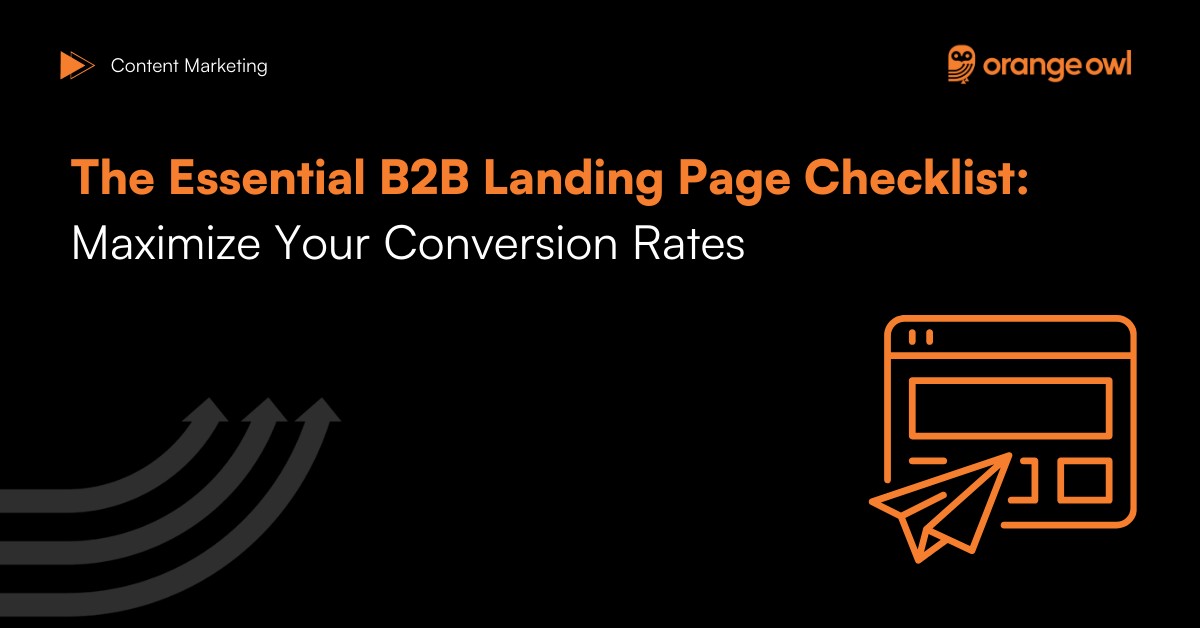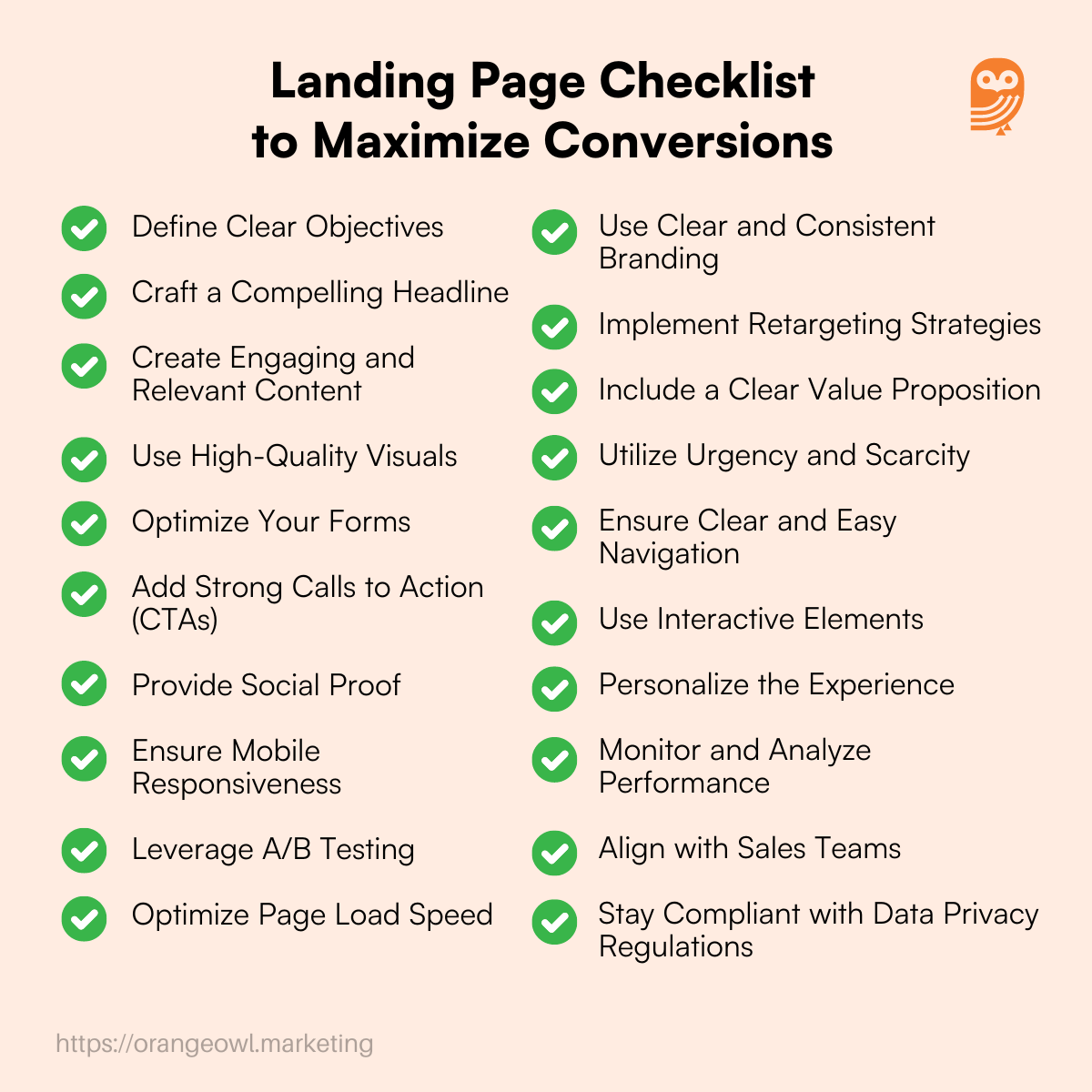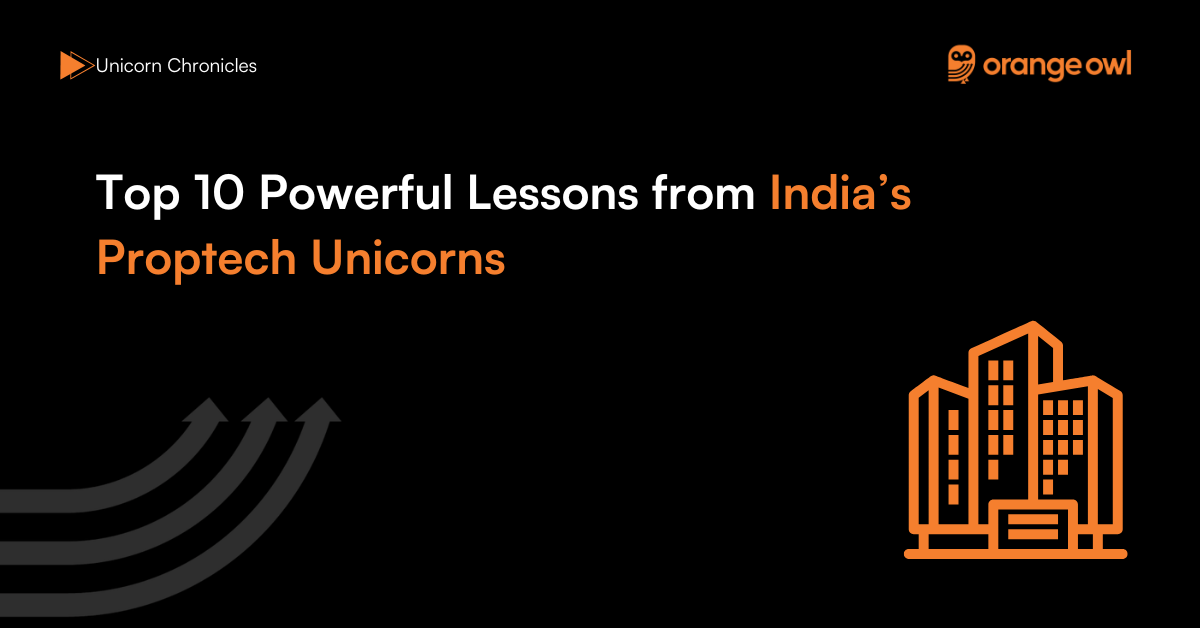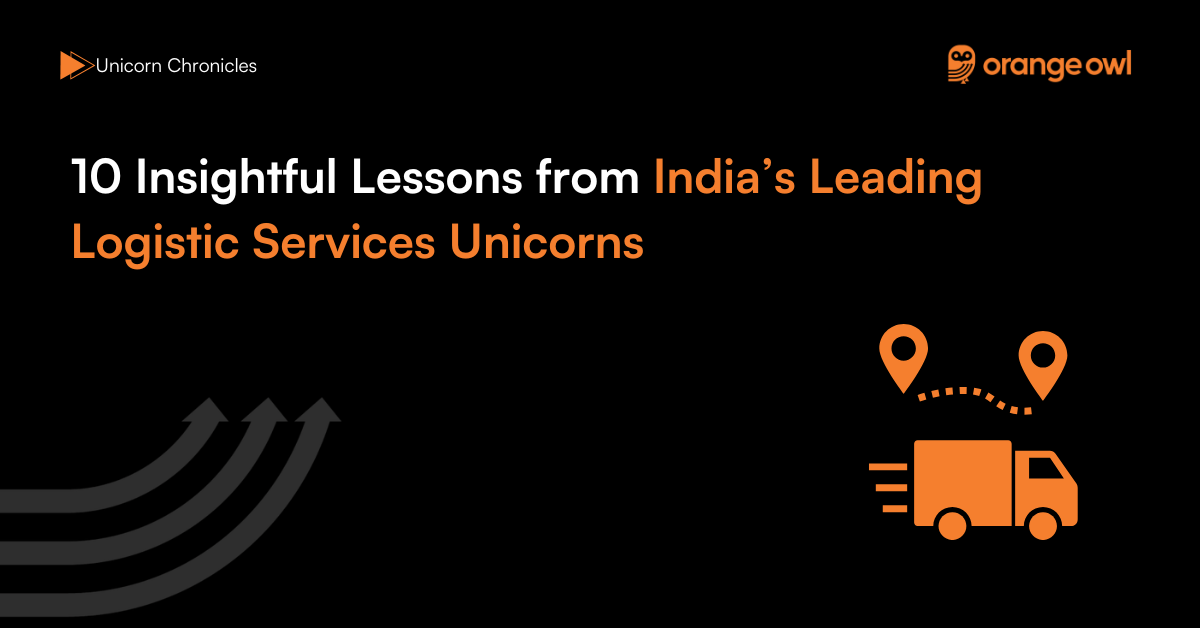The Essential B2B Landing Page Checklist: Maximize Your Conversion Rates
Vivek Goel
February 4, 2025

Table of Contents
Creating effective landing pages is crucial for the success of any B2B performance marketing campaign. Even if you manage to drive significant traffic to your landing page, it’s all in vain if you can’t convert those visitors into leads or customers. This blog post will provide you with a comprehensive landing page checklist of actionable items to ensure your landing pages are optimized for high conversion rates.
Let’s dive into the top strategies and best practices for creating landing pages that convert.
The 20 Point Landing Page Checklist to Maximize Conversions
1. Define Clear Objectives
Action Item:
- Clearly define the purpose of your landing page. Is it to capture leads, promote a product, or encourage event sign-ups?
Tips:
- Ensure your objective is specific and measurable. For example, instead of just capturing leads, aim to capture 100 qualified leads in a month.
- Align the landing page objectives with your overall marketing goals.
- Revisit and adjust your objectives periodically based on performance metrics.
2. Craft a Compelling Headline
Action Item:
- Write a clear, concise, and compelling headline that grabs attention and conveys the value proposition.
Tips:
- Use action-oriented language and address the pain points of your target audience.
- Keep it under 10 words to ensure it’s easily scannable.
- Test multiple headlines through A/B testing to determine which resonates best.
3. Create Engaging and Relevant Content
Action Item:
- Provide valuable content that resonates with your audience and addresses their needs and interests.
Tips:
- Use bullet points, short paragraphs, and subheadings to make your content easy to read.
- Highlight the benefits over features to appeal to the visitor’s emotions.
- Include customer testimonials or case studies to build credibility.
4. Use High-Quality Visuals
Action Item:
- Include high-quality images, videos, and infographics that support your message and enhance the user experience.
Tips:
- Ensure your visuals are relevant and help to illustrate the benefits of your offer.
- Use images of real people and real products to build trust.
- Optimize images for fast loading to avoid slowing down your page.
5. Optimize Your Forms
Action Item:
- Design user-friendly forms that are easy to fill out and don’t ask for too much information.
Tips:
- Only ask for essential information to reduce friction and increase the likelihood of form submissions.
- Use a single-column layout to improve readability and ease of completion.
- Include a clear and compelling call-to-action (CTA) on your form’s submit button.

6. Add Strong Calls to Action (CTAs)
Action Item:
- Include clear and compelling CTAs that tell visitors exactly what you want them to do.
Tips:
- Use action verbs and create a sense of urgency. Ensure your CTAs stand out visually.
- Position your primary CTA above the fold to ensure visibility without scrolling.
- Experiment with different CTA text and button colours through A/B testing.
7. Provide Social Proof
Action Item:
- Include testimonials, case studies, and reviews to build credibility and trust.
Tips:
- Use real quotes from satisfied customers and, if possible, include their photos and job titles.
- Highlight well-known clients or partners to leverage their credibility.
- Feature any awards or recognitions your company or product has received.
8. Ensure Mobile Responsiveness
Action Item:
- Optimize your landing page for mobile devices to ensure a seamless experience across all screen sizes.
Tips:
- Use responsive design techniques and test your landing page on multiple devices.
- Avoid using pop-ups or elements that don’t work well on mobile.
- Ensure that buttons and forms are easy to interact with on a touchscreen.
9. Leverage A/B Testing
Action Item:
- Conduct A/B testing on different elements of your landing page, such as headlines, CTAs, images, and forms.
Tips:
- Test one element at a time to determine what works best and continuously optimize based on the results.
- Use tools like Google Optimize or Optimizely to streamline your A/B testing process.
- Analyze test results thoroughly to understand what drives higher conversions.
10. Optimize Page Load Speed
Action Item:
- Ensure your landing page loads quickly to prevent visitors from bouncing due to slow load times.
Tips:
- Use tools like Google PageSpeed Insights to identify and fix performance issues.
- Compress images and use a content delivery network (CDN) to speed up load times.
- Minimize HTTP requests by reducing the number of elements on the page.
11. Use Clear and Consistent Branding
Action Item:
- Maintain consistent branding elements such as colors, fonts, and logos to reinforce brand recognition.
Tips:
- Ensure your landing page aligns with your overall brand identity and messaging.
- Use the same brand colors and fonts that are used on your main website.
- Include your logo in a prominent position to reinforce brand identity.
12. Implement Retargeting Strategies
Action Item:
- Set up retargeting campaigns to reach visitors who didn’t convert on their first visit.
Tips:
- Use personalized ads that remind visitors of your offer and encourage them to return and complete the desired action.
- Segment your audience based on their interaction with your landing page to deliver more relevant retargeting ads.
- Use platforms like Facebook Ads and Google Ads for effective retargeting.
13. Include a Clear Value Proposition
Action Item:
- Clearly articulate the value your offer provides and how it benefits the visitor.
Tips:
- Highlight the unique selling points (USPs) and use bullet points to make it easy to understand.
- Focus on the benefits that directly address the visitor’s pain points.
- Use subheadings to break down the value proposition into digestible chunks.
14. Utilize Urgency and Scarcity
Action Item:
- Create a sense of urgency or scarcity to encourage immediate action.
Tips:
- Use phrases like “Limited Time Offer,” “Only a Few Spots Left,” or countdown timers to motivate visitors to act quickly.
- Highlight deadlines or limited availability in your CTAs.
- Combine urgency with compelling offers to increase conversions.
15. Ensure Clear and Easy Navigation
Action Item:
- Design your landing page with clear navigation to guide visitors toward the desired action without distractions.
Tips:
- Minimize external links and keep the focus on the primary CTA.
- Use anchor links to direct visitors to specific sections of the page.
- Ensure the layout is intuitive and logical, making it easy for visitors to find what they need.
16. Use Interactive Elements
Action Item:
- Incorporate interactive elements like quizzes, calculators, or surveys to engage visitors and gather information.
Tips:
- Ensure interactive elements are relevant and add value to the visitor’s experience.
- Use interactive content to guide visitors through the sales funnel.
- Analyze the data collected from interactive elements to refine your marketing strategy.
17. Personalize the Experience
Action Item:
- Use personalization techniques to tailor the landing page experience to individual visitors.
Tips:
- Use dynamic text replacement to personalize headlines and CTAs based on visitor data.
- Segment your audience and create tailored content for different segments.
- Use visitor data to deliver personalized recommendations or offers.
18. Monitor and Analyze Performance
Action Item:
- Continuously monitor and analyze the performance of your landing page to identify areas for improvement.
Tips:
- Use analytics tools like Google Analytics to track key metrics such as bounce rate, conversion rate, and average session duration.
- Set up conversion tracking to measure the effectiveness of your CTAs and forms.
- Regularly review and update your landing page based on performance data.
19. Align with Sales Teams
Action Item:
- Ensure your landing page strategy is aligned with your sales teams to maximize lead quality and conversion rates.
Tips:
- Collaborate with sales to define lead qualification criteria and ensure the landing page captures relevant information.
- Use lead scoring to prioritize and follow up with the most promising leads.
- Provide sales with the necessary tools and information to effectively follow up with leads generated from the landing page.
20. Stay Compliant with Data Privacy Regulations
Action Item:
- Ensure your landing page complies with data privacy regulations such as GDPR, CCPA, and others.
Tips:
- Include clear and concise privacy policies and terms of service on your landing page.
- Use opt-in forms and obtain explicit consent for data collection.
- Ensure data is securely stored and managed according to privacy regulations.
Conclusion
Creating landing pages that convert is essential for the success of your B2B marketing campaigns. By following this comprehensive checklist, you can optimize your landing pages to drive higher conversions and achieve your marketing goals. From defining clear objectives and crafting compelling headlines to leveraging A/B testing and ensuring mobile responsiveness, each action item plays a crucial role in enhancing your landing page’s effectiveness.
Remember, the key to a high-converting landing page is understanding your audience and addressing their needs with tailored, valuable content. Continuously test, analyze, and optimize your landing pages to stay ahead of the competition and maximize your conversion rates.
By implementing these best practices, you’ll be well on your way to creating landing pages that not only attract traffic but also convert visitors into valuable leads and customers for your B2B business.
Also, check out Top 10 Ways to Generate More Leads on Your Website Through Content Optimization
Top Frequently Asked Questions (FAQs) About Creating High-Converting B2B Landing Pages
Social proof can significantly enhance the credibility of your landing page. Apart from testimonials, consider including customer logos, case studies, user-generated content, and real-time activity notifications. For example, displaying a rotating banner of well-known clients or partners can immediately build trust. Additionally, integrating live activity feeds showing recent sign-ups or purchases can create a sense of urgency and popularity.
Beyond simple headline and CTA testing, advanced A/B testing techniques include multivariate testing (testing multiple elements simultaneously), sequential testing (testing variations in a specific sequence), and cross-device testing (ensuring variations work across different devices). For instance, you could test different form placements, background colors, or navigation structures to see which combination drives the highest conversions.
Storytelling can make your landing page more engaging and relatable. Start with a compelling narrative that outlines a common problem your target audience faces, followed by how your product or service solves this issue. Use customer success stories and case studies to illustrate real-world applications and benefits. This approach helps to humanize your brand and make your value proposition more compelling.
SEO ensures your landing page is discoverable by search engines, driving organic traffic. Focus on keyword optimization in your headlines, subheadings, and content. Meta descriptions, alt tags for images, and a clean URL structure are also crucial. Additionally, ensure fast load times and mobile optimization, as these factors influence search engine rankings.
Exit-intent popups detect when a user is about to leave the page and display a targeted message to retain them. Effective exit-intent popups offer incentives such as discounts, free trials, or valuable content (e.g., an eBook). Ensure the popup is relevant and not intrusive. For example, if a user is exiting from a product page, offer a discount on that product or a related item.
Accessibility ensures that all users, including those with disabilities, can navigate and interact with your landing page. Use descriptive alt text for images, ensure high contrast between text and background, provide keyboard navigation, and use ARIA (Accessible Rich Internet Applications) labels. Tools like WAVE and Axe can help you test and improve your page’s access
Reducing bounce rates involves ensuring visitors stay and engage with your content. Strategies include improving page load speed, ensuring the content matches visitor intent, using engaging visuals and interactive elements, and having a clear, compelling CTA. Also, offer multiple ways for visitors to engage, such as videos, infographics, or downloadable content.
Use analytics tools like Google Analytics to track key metrics such as bounce rate, conversion rate, average session duration, and traffic sources. Implement heatmaps with tools like Hotjar to see where visitors click and scroll. Set up goals and conversion tracking to measure the effectiveness of your CTAs and form submissions. Regularly review and analyze this data to make informed optimizations.
Microcopy includes the small bits of text that guide users, such as form field instructions and button labels. Effective microcopy is clear, concise, and action-oriented. For forms, use placeholders and tooltips to clarify what information is required. For buttons, use direct language like “Download Now” or “Get Your Free Quote” instead of generic terms like “Submit.” Ensure the microcopy aligns with your brand voice.
Personalization involves tailoring the landing page experience to individual visitors. Use dynamic content that changes based on visitor behavior, demographics, or previous interactions. For example, greet returning visitors by name, show content related to their past activities, or recommend products based on their browsing history. Tools like HubSpot and Optimizely can help implement these personalized experiences effectively.


